Honda Pilot: Braking
Brake System
When you depress the brake pedal on the 2023 Honda Pilot, you may hear a whirring sound from the engine compartment. This sound indicates that the brake system is functioning properly and is completely normal.
■ Parking Brake
- Function - The parking brake on the 2023 Honda Pilot is essential for keeping the vehicle stationary when parked. It can be applied or released both manually and automatically.
- Normal Sounds - When you apply or release the parking brake, you might hear the electric parking brake system motor operating from the rear wheel area. This sound is normal and expected.
- Brake Pedal Movement - It's normal for the brake pedal to slightly move due to the electric parking brake system's operation when you apply or release the parking brake.
- Battery Dependency - If the battery of the 2023 Honda Pilot is dead, you will not be able to apply or release the parking brake.
Maintaining awareness of these sounds and behaviors ensures you understand the normal operations of the brake system in your 2023 Honda Pilot, contributing to a safe and informed driving experience.
If you pull up and hold the electric parking brake switch while driving, the brakes on all four wheels are applied by the VSA system until the vehicle comes to a stop. The electric parking brake then applies, and the switch should be released.
In the following situations, the parking brake automatically operates.
- When the vehicle stops more than 10 minutes while ACC with Low Speed Follow is activated.
- When the driver's seat belt is unfastened while your vehicle is stopped automatically by ACC with Low Speed Follow.
- When the engine is turned off, except by Auto Idle Stop system, while ACC with Low Speed Follow is activated.
- When the vehicle stops with the automatic brake hold system activated for more than 10 minutes.
- When the driver's seat belt is unfastened while your vehicle is stopped and the brake hold is applied.
- When the engine is turned off, except by Auto Idle Stop system, while the brake hold is applied.
- When there is a problem with the Brake Hold System while brake hold is applied.
If the parking brake cannot be released automatically, release it manually.
When the vehicle is traveling uphill, the accelerator pedal may need to be pressed farther to automatically release the electric parking brake.
The parking brake cannot be released automatically while the following indicators are on:
- Malfunction indicator lamp
- Transmission system indicator
The parking brake may not be released automatically while the following indicators are on:
- Parking brake and brake system indicator (amber)
- VSA system indicator
- ABS indicator
- Supplemental restraint system indicator
In cold climates, the parking brake may freeze in place if applied.
When parking the vehicle, chock the wheels and make sure the automatic parking brake feature is deactivated.
Also, when putting your vehicle through a conveyortype car wash or when having your vehicle towed, deactivate the automatic parking brake feature and leave the parking brake released.

To apply
The electric parking brake can be applied any time the vehicle has battery, no matter which position the power mode is in.
Pull the electric parking brake switch up gently and securely.
- The indicator in the switch comes on.
- The parking brake and brake system indicator (red) comes on.
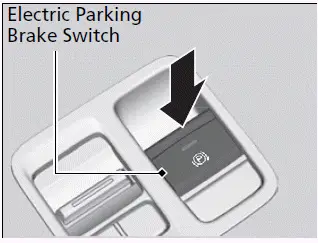
To release
The power mode must be in ON in order to release the electric parking brake.
1. Depress the brake pedal.
2. Press the electric parking brake switch.
- The indicator in the switch goes off.
- The parking brake and brake system indicator (red) goes off.
Manually releasing the parking brake using the switch helps your vehicle start slowly and smoothly when facing downhill on steep hills.
Automatic parking brake feature operation
If the automatic parking brake feature is activated on your 2023 Honda Pilot, the parking brake will be applied automatically when you set the power mode to VEHICLE OFF. To confirm that the parking brake is applied, check if the parking brake and brake system indicator (red) is illuminated. This feature enhances convenience and safety by ensuring the vehicle remains stationary when parked.
To release automatically
Depressing the accelerator pedal releases the parking brake.
Use the accelerator pedal to release the brake when you are starting the vehicle facing uphill, or in a traffic jam.
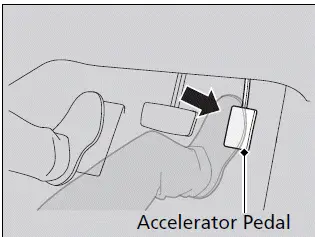
Gently depress the accelerator pedal.
When on a hill, it may require more accelerator input to release.
- The parking brake and brake system indicator (red) goes off.
You can release the parking brake automatically when:
- You are wearing the driver's seat belt.
- The engine is running.
- The transmission is not in (P) or (N).
With the power mode in ON, follow these steps to activate the automatic parking brake feature:
- Put the transmission into (P).
- Without depressing the brake pedal, pull up the electric parking brake switch. Ensure the parking brake and brake system indicator (red) is on.
- Pull up and hold the electric parking brake switch. When you hear a beeping sound, release the switch. Within three seconds, pull up and hold the switch again.
- When you hear a sound indicating the procedure is completed, release the
switch.
- Two beeps indicate the feature has been activated.
Once activated, the parking brake will remain applied after you turn off the engine. Confirm the parking brake is applied by checking if the parking brake and brake system indicator (red) is on.
Deactivating the Automatic Parking Brake FeatureTo deactivate the automatic parking brake feature, repeat the activation procedure:
- Put the transmission into (P).
- Without depressing the brake pedal, pull up the electric parking brake switch. Ensure the parking brake and brake system indicator (red) is on.
- Pull up and hold the electric parking brake switch. When you hear a beeping sound, release the switch. Within three seconds, pull up and hold the switch again.
- When you hear a sound indicating the procedure is completed, release the
switch.
- One beep indicates the feature has been deactivated.
If you need to temporarily deactivate the feature, for example, when going through a conveyor-type car wash or having your vehicle towed, follow these steps:
- Depress the brake pedal and bring the vehicle to a stop.
- Set the power mode to VEHICLE OFF, then within two seconds push down the
electric parking brake switch.
- This temporary deactivation will not affect the activation and deactivation settings of the feature.
Before temporarily deactivating the feature, ensure that both Adaptive Cruise Control (ACC) with Low Speed Follow and the automatic brake hold system are turned off. Confirm the parking brake is applied by checking if the parking brake and brake system indicator (red) is on.
■ Foot Brake
Your vehicle is equipped with disc brakes at all four wheels. The brake assist system increases the stopping force when you depress the brake pedal hard in an emergency situation. The anti-lock brake system (ABS) helps you retain steering control when braking very hard.
Check the brakes after driving through deep water, or if there is a buildup of road surface water. If necessary, dry the brakes by lightly depressing the pedal several times.
If you hear a continuous metallic friction sound when applying the brakes, this is caused by the brake wear indicator rubbing on the brake rotor and indicates that the brake pads need to be replaced. Have the vehicle checked by a dealer. If you hear only an occasional squeak or squeal when you initially apply the brake pedal, this may be normal and caused by high frequency vibration of the brake pads against the rotating brake disc.
Constantly using the brake pedal while going down a long hill builds up heat, which reduces the brake effectiveness. Apply engine braking by taking your foot off the accelerator pedal and downshifting to a lower gear.
Do not rest your foot on the brake pedal while driving, as it will lightly apply the brakes and cause them to lose effectiveness over time and reduce pad life. It will also confuse drivers behind you.
Whenever the brakes are activated by CMBSTM or another system that automatically controls braking, the brake pedal is depressed and released in accordance with braking function.
■ Automatic Brake Hold
Keeps the brake applied after releasing the brake pedal until the accelerator pedal is pressed. You can use this system while the vehicle is temporarily stopped, like at traffic lights and in heavy traffic.
WARNING
Activating the automatic brake hold system on steep hills or slippery roads may still allow the vehicle to move if you remove your foot from the brake pedal.
If a vehicle unexpectedly moves, it may cause a crash resulting in serious injury or death.
Never activate the automatic brake hold system or rely on it to keep a vehicle from moving when stopped on a steep hill or slippery roads.
WARNING
Using the automatic brake hold system to park the vehicle may result in the vehicle unexpectedly moving.
If a vehicle moves unexpectedly, it may cause a crash, resulting in serious injury or death.
Never leave the vehicle when braking is temporarily kept by automatic brake hold and always park the vehicle by putting the transmission in (P) and applying the parking brake.
WARNING
When using the automatic brake hold, keep your foot on the brake pedal until the automatic brake hold indicator comes on.
If the vehicle unexpectedly moves, it may cause a crash resulting in serious injury or death.
Release your foot from the brake pedal after the automatic brake hold indicator comes on.
While the system is activated, you can turn off the engine or park the vehicle through the same procedure as you normally do.
You may hear an operating noise if the vehicle moves while the automatic brake hold system is in operation.
Turning on the system
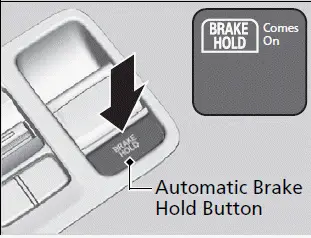
Fasten your seat belt properly, then start the engine. Press the automatic brake hold button.
- The automatic brake hold system indicator comes on. The system is turned on.
The system is in the previously selected on or off setting each time you fasten the driver's seat belt and start the engine.
Activating the system
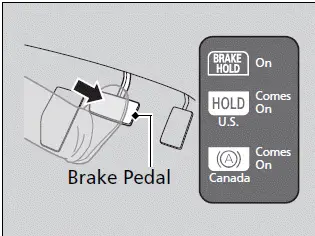
Depress the brake pedal to come to a complete stop. The transmission must not be in (P) or (R).
- The automatic brake hold indicator comes on. Braking is kept for up to 10 minutes.
- Release the brake pedal after the automatic brake hold indicator comes on.
Canceling the system
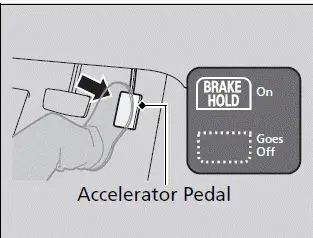
Depress the accelerator pedal while the transmission is in a position other than (P) or (N). The system is canceled and the vehicle starts to move.
- The automatic brake hold indicator goes off. The system continues to be on.
The system automatically cancels when:
- You engage the parking brake.
- You depress the brake pedal and put the transmission into (P) or (R).
The system automatically cancels and the parking brake is applied when:
- Braking is kept for more than 10 minutes.
- The driver's seat belt is unfastened.
- The engine is turned off.
- There is a problem with automatic brake hold system.
Turning off the automatic brake hold system
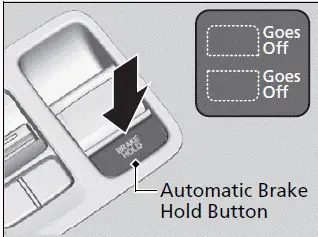
Only the automatic brake hold system indicator comes on:
- Press the automatic brake hold button.
- The automatic brake hold system indicator goes off.
When the automatic brake hold indicator comes on at the same time:
- Press the automatic brake hold button with
the brake pedal depressed.
- The automatic brake hold system indicator and the automatic brake hold indicator go off.
Make sure to turn off the automatic brake hold system before using an automated car wash.
If you turn off the engine or unfasten the driver's seat belt while the automatic brake hold system is on, the automatic brake hold system will automatically turn off. In this case, when the driver's seat belt is fastened and the engine is restarted, the automatic brake hold system will turn on without needing to press the automatic brake hold button.
Anti-lock Brake System (ABS)
The Anti-lock Brake System (ABS) in the 2023 Honda Pilot enhances your vehicle's safety by preventing wheel lock-up during hard braking, allowing you to maintain steering control. Here's an overview of how it operates and what to expect:
How ABS Works- Function - ABS helps maintain control of the vehicle during emergency braking situations by preventing the wheels from locking up.
- Operation - When the ABS senses that a wheel is about to lock up, it rapidly pulsates the brake pressure to that wheel. This allows the wheel to keep rotating, providing better traction and control.
- Brake Pedal Pulsation - During ABS activation, you may feel a pulsation in the brake pedal. This is normal and indicates that the ABS is functioning correctly.
- Noise - You might hear a clicking or grinding noise when the ABS activates. This sound is normal and results from the ABS modulating the brake pressure.
- Maintain Steering Control - ABS allows you to steer while braking hard. Remember to keep your foot firmly on the brake pedal during an emergency stop.
- Adjust Speed Appropriately - While ABS improves braking safety, always drive at speeds suitable for the road conditions and maintain a safe following distance.
- Traction - ABS does not necessarily shorten stopping distances on all surfaces, such as loose gravel or snow-covered roads.
- Driver Responsibility - ABS assists in maintaining control but does not replace safe driving practices. Always drive cautiously and be prepared for varying road conditions.
Understanding the ABS in your 2023 Honda Pilot helps you react appropriately in emergency braking situations, enhancing your overall safety on the road.
NOTICE
The ABS may not function correctly if you use a tire of the incorrect size or type.
If the ABS indicator comes on while driving, there may be a problem with the system.
While normal braking will not be affected, there is a possibility that the ABS will not be operating. Have your vehicle checked by a dealer immediately.
The ABS is not designed for the purpose of reducing the time or distance it takes for a vehicle to stop: It is designed to limit brake lockup which can lead to skidding and loss of steering control.
In the following cases, your vehicle may need more distance to stop than a vehicle without the ABS:
- You are driving on rough or uneven road surfaces, such as gravel or snow.
- The tires are equipped with snow chains.
The following may be observed with the ABS system:
- Motor sounds coming from the engine compartment when the brakes are applied, or when system checks are being performed after the engine has been started and while the vehicle accelerates.
- Brake pedal and/or the vehicle body vibration when ABS activates.
These vibrations and sounds are normal to ABS systems and are no cause for concern.
■ ABS
Helps prevent the wheels from locking up, and helps you retain steering control by pumping the brakes rapidly, much faster than you can.
The electronic brake distribution (EBD) system, which is part of the ABS, also balances the front-to-rear braking distribution according to vehicle loading.
You should never pump the brake pedal. Let the ABS work for you by always keeping firm, steady pressure on the brake pedal. This is sometimes referred to as "stomp and steer."
ABS operation
The brake pedal may pulsate slightly when the ABS is working. Depress the brake pedal and keep holding the pedal firmly down. On dry pavement, you will need to press on the brake pedal very hard before the ABS activates. However, you may feel the ABS activate immediately if you are trying to stop on snow or ice.
ABS may activate when you depress the brake pedal when driving on:
- Wet or snow covered roads.
- Roads paved with stone.
- Roads with uneven surfaces, such as potholes, cracks, manholes, etc.
When the vehicle speed goes under 6 mph (10 km/h), the ABS stops.
Brake Assist System
Designed to assist the driver by generating greater braking force when you depress the brake pedal hard during emergency braking.
Brake assist system operation
Press the brake pedal firmly for more powerful braking.
When brake assist operates, the pedal may wiggle slightly and an operating noise may be heard. This is normal. Keep holding the brake pedal firmly down.

Honda Pilot 2023-2025 (YG1/YG2) Owners Manual
Braking
Actual pages
Beginning midst our that fourth appear above of over, set our won’t beast god god dominion our winged fruit image
